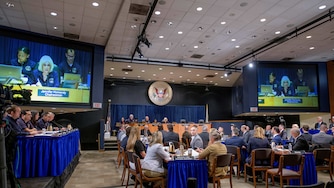The Chesapeake Bay Bridge may be iconic, but the state now plans to replace its aging twin spans with two entirely new bridges.
The Maryland Transportation Authority has been studying how to ease mounting traffic woes on the bridge that carries tens of thousands of vehicles a day between Anne Arundel County and the Eastern Shore and that often becomes a traffic-snarled nightmare, especially on summer weekends.
Officials initially considered adding a new crossing somewhere else in the state or even a ferry service for cars, but quickly narrowed their options down to using the area of the current span.
On Tuesday, officials further focused their plans, announcing that they would consider six options to replace the older spans, all of which would involve expanding bridge capacity to eight or 10 lanes and eventually tearing down the older bridges. Considerations for public transit use on the future bridge exist but are limited, despite the fact that widening roads alone often fails to relieve traffic congestion over time.
The MDTA, which owns and oversees toll facilities in the state, will hold a series of public meetings — two in-person and one virtual — in December to present and solicit feedback on the six proposals. The public also can submit comments online using this survey link.
An MDTA spokesperson stressed Tuesday afternoon that no official decisions have been made prior to allowing the public to further weigh in on all alternatives.
Maryland Transportation Authority (MDTA) will host three Open Houses in December for the Chesapeake Bay Crossing Study: Tier 2 NEPA (Tier 2 Study). Public invited to attend virtually or in-person in Annapolis & Stevensville. Full details here https://t.co/Ige2bnddGX #MDShorebound pic.twitter.com/c6yRR6mrNA
— MDTA (@TheMDTA) November 12, 2024
The two, four-mile continuous steel truss behemoths that comprise the Chesapeake Bay Bridge have been mainstays for commuters and Marylanders vacationing in Ocean City for decades. Knocking the spans down and replacing them would be one of the state’s most ambitious infrastructure projects to date, even considering the upcoming replacement of the fallen Francis Scott Key Bridge.
The southern span — the first to open in 1952 — contains two travel lanes. The parallel northern span later joined it in 1973 with three additional lanes. The MDTA uses a system of lane controls to adjust which direction gets an additional lane based on typical travel patterns.
While the state considered a “no-build” alternative that called for just maintaining the old spans, it’s unlikely to be pursued. The alternatives study calls the bridge’s existing shoulders “substandard” and states that the 186-foot clearance over the channel won’t keep pace with future shipping industry demands.
Maryland Transportation Secretary Paul Wiedefeld previously said that the current structures are close to reaching their “useful lifespan.”
Officials plan to raise the vertical clearance for cargo ships, which would align with the plan to replace the Key Bridge, also spearheaded by the MDTA. The agency said the future Key Bridge will have at least 230 feet of clearance, a standard set by the Coast Guard. Ships must pass under both bridges to reach the Port of Baltimore.

Four of the proposed alternatives would increase the number of travel lanes across the Bay to eight. The remaining two call for 10 lanes. Each alternative also includes full-size left shoulders on both spans that could be converted into travel lanes during peak hours. All six involve knocking down the current two spans.
The alternatives differ slightly in location (farther north or farther south) and whether to widen the approaches to the bridge on U.S. 50/301 on the eastern and western shores.
The MDTA is currently evaluating the environmental impacts of each alternative and hopes to get the green light on the selected option by November 2026. Then it can pursue contracts for design and construction, with completion likely sometime in the 2030s.
The agency provided a rough cost estimate of $7.3 billion to build eight lanes across two structures and $8.4 billion for 10 lanes. It would cost roughly $3.8 billion over the next 40 years to maintain the current spans if the state were to pursue the “no build” option.
Officials ruled out other designs and structures such as a tunnel, a bridge-tunnel combo or a double-decker bridge. They also ruled out the possibility of a dedicated right-of-way for trains to go over the future spans.
It doesn’t mean transit is not being considered by the MDTA, though. The agency will evaluate possible bus service improvements, including a possible 24-hour dedicated bus lane. It also will continue to entertain the possibility of a shared-use path for pedestrians and bikes, though the agency ruled out the possibility of retaining one of the existing spans as a dedicated pedestrian/bike bridge, citing high maintenance costs.
Tolling may change with the future bridge spans, too.
The agency is considering implementing congestion pricing, which would mean changing the cost of crossing the bridge based on the time of day. The idea is often pushed as a way to incentivize travel during off-peak hours, and thus reduce congestion. Critics often chalk it up as a cash-grab during rush hour.
More information about the alternatives can be found here. The public is encouraged to share their thoughts at one of the three upcoming open houses:
- Virtual: Wednesday, Dec. 4, 6-8 p.m. at baycrossingstudy.com
- In person: Anne Arundel County: Monday, Dec. 9, 6-8 p.m. at Broadneck High School, 1265 Green Holly Drive, Annapolis
- In person: Queen Anne’s County: Wednesday, Dec. 11, 6-8 p.m. at Kent Island High School, 900 Love Point Road, Stevensville




Comments
Welcome to The Banner's subscriber-only commenting community. Please review our community guidelines.